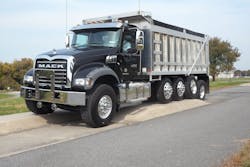It’s not every day or even every year that Mack Trucks comes out with a new suspension. But at the 2013 Mid-America Trucking Show in Louisville, Ky., execs with the Bulldog Brand announced not one but two products: the Twin Y highway air suspension, which later won the Truck Writers of North America’s annual Technical Achievement Award for its simplicity and light weight, and the mRide steel-spring suspension for vocational trucks.
Last fall, Mack hosted a demonstration of the suspensions at its Customer Care Center in Allentown, Pa., where editors who can also drive were invited to give them some real seat-of-the-pants tryouts. I briefly drove the Twin Y on the nearby smoothly paved oval track, then pounced on the mRide because it was mounted on a Granite dumper: an appropriate vehicle with a purposeful component to cover in a Construction Equipment article.
Test Set
Truck: Mack Granite GU713 Cornerstone vocational chassis
Engine: 12.8-liter MP 8-455M (Maxidyne) with Powerleash retarder
Transmission: Allison 4500 RDS automatic 6-speed
Front axle: 20,000-lb. Mack FXL on taperleafs
Lift axles: 13,200-lb. Watson-Chalin S11
Tandem: 46,000-lb. Mack S-462R w/ 4.19 ratio, on 46,000-lb. Mack mRide six-rod, steel-spring vocational suspension
Wheelbase: 268 inches
Tires & wheels: 425/65R22.5 Bridgestone M844F front, 11R22.5 M726EL rear, on Alcoa aluminum discs
Fuel tank: 111-gal. polished aluminum, left side
Body: DuraClass Alumax 20-yd. aluminum dump
At some point, I puzzled over the name as being a little confusing because Mack also has an “mDrive”: its excellent automated mechanical transmission that’s based on the I-Shift from Volvo, Mack’s sibling company. Couldn’t they have called the suspension something else? Well, mRide is claimed to be more agile than the venerable Camelback, a product that Mack customers have been using for generations.
We will observe, as Mack enthusiasts have at BigMackTrucks.com, that the mRide, a “six-rod, steel-spring” suspension, is very close in appearance to Volvo’s T-Ride. Some charged that Mack simply substituted an “m” for the T and put it on the market. Yet, a close look reveals differences in the leaf-spring packs of the two suspensions and probably other changes. Says Stu Russoli, Mack’s construction product marketing manager, “The mRide operates off of the same basic principles and proven technology, but was optimized to mate with our Mack proprietary axles to offer improved performance.” For that matter, both products look a lot like a similar vocational suspension, Freightliner’s TufTrac. Or does it look like them?
Design-wise, the mRide could be considered a slimmed-down and updated Camelback. Both use arched leaf-spring packs that cushion the chassis against rough terrain and tie together a tandem’s axle ends. Walking beams do that, but neither of these are walking beams because beams are rigid bars whereas the spring packs flex, Russoli said. An mRide’s spring packs contain fewer leafs and are much less massive than a Camelback’s, which accounts for an mRide’s weight savings of 104 to 642 pounds, depending on capacity. There are four: 40,000, 46,000, 50,000 and 52,000 pounds, and different spring packs are used for each.
An mRide also has four low-slung longitudinal rods that, like the leaf spring pack, are connected to the two central trunions and help the spring packs keep the axle ends in place. As the nearby illustration shows, this suspension also has four shock towers to manage jolts and four shock absorbers to handle jounce, especially when the truck is lightly loaded or empty. And there are a pair of V-rods to control torque forces and ease axle alignment. The mRide might have as many or more parts then a Camelback, but the mRide’s lower weight is important these days as modern diesels with their bulky exhaust aftertreatment equipment have become heavier—and its design is more modern.
The mRide is more agile, and during my driving it walked rather smoothly over uneven pavement and rough trails on a nearby off-road course. Out of respect for equipment—that is, the handsome Granite and everything on and in it—I ran over these surfaces rather slowly and could feel vertical movement at the truck’s rear. Once I sped up to try to induce some shock, but there wasn’t much. Articulation—how much the suspension allows a wheel to rise and fall—is a tall 15 inches.
This low-speed exercise was easy because the 455-horsepower MP 8 diesel ran through an Allison 4500 automatic transmission that took most of the work out of driving. The truck’s long wheelbase may have helped with the ride, and so might the two Watson-Chalin pusher axles had I thought to lower them to the ground. Instead, they stayed raised so the mRide-equipped 46,000-pound tandem and the 20,000-pound front axle would be properly challenged. Initially, mRide was available only with Mack’s proprietary axles, but now vendor axles can also be fitted with it.
Customers are taking to mRide, Russoli says.
“We’ve seen some movement from the Camelback to the mRide spring suspension since the mRide offers a significant weight savings and a smoother ride, while still offering similar durability and articulation characteristics as the Camelback. It all depends if the application is weight-sensitive.
“We’ve seen refuse and mixer customers moving to the mRide because of its low maintenance,” he says. “It requires no lubrication, hardly any adjustments are needed and it’s very light weight. The lighter weight amounts to more payload per trip and more payback for the customer.”
But “the Camelback is a great suspension, and many will stay with it,” he says. It goes as high as 65,000 pounds in capacity and offers more axle spacings. The Camelback’s strong following is borne out in comments found online; one user calls it “the best truck suspension ever made.” So it will continue and the mRide will supplement it. If you’re a Mack user, you’ll probably form your own opinion on the new product as time goes on.





